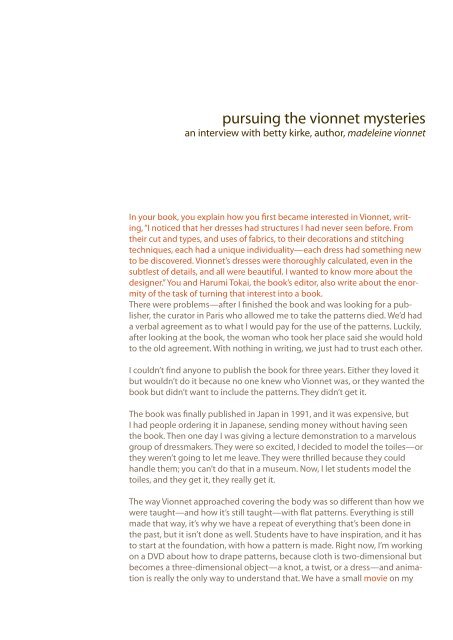discovering vionnet (again) - Horner & Company
discovering vionnet (again) - Horner & Company
discovering vionnet (again) - Horner & Company
You also want an ePaper? Increase the reach of your titles
YUMPU automatically turns print PDFs into web optimized ePapers that Google loves.
pursuing the <strong>vionnet</strong> mysteries<br />
an interview with betty kirke, author, madeleine <strong>vionnet</strong><br />
In your book, you explain how you first became interested in Vionnet, writing,<br />
“I noticed that her dresses had structures I had never seen before. From<br />
their cut and types, and uses of fabrics, to their decorations and stitching<br />
techniques, each had a unique individuality—each dress had something new<br />
to be discovered. Vionnet’s dresses were thoroughly calculated, even in the<br />
subtlest of details, and all were beautiful. I wanted to know more about the<br />
designer.” You and Harumi Tokai, the book’s editor, also write about the enormity<br />
of the task of turning that interest into a book.<br />
There were problems—after I finished the book and was looking for a publisher,<br />
the curator in Paris who allowed me to take the patterns died. We’d had<br />
a verbal agreement as to what I would pay for the use of the patterns. Luckily,<br />
after looking at the book, the woman who took her place said she would hold<br />
to the old agreement. With nothing in writing, we just had to trust each other.<br />
I couldn’t find anyone to publish the book for three years. Either they loved it<br />
but wouldn’t do it because no one knew who Vionnet was, or they wanted the<br />
book but didn’t want to include the patterns. They didn’t get it.<br />
The book was finally published in Japan in 1991, and it was expensive, but<br />
I had people ordering it in Japanese, sending money without having seen<br />
the book. Then one day I was giving a lecture demonstration to a marvelous<br />
group of dressmakers. They were so excited, I decided to model the toiles—or<br />
they weren’t going to let me leave. They were thrilled because they could<br />
handle them; you can’t do that in a museum. Now, I let students model the<br />
toiles, and they get it, they really get it.<br />
The way Vionnet approached covering the body was so different than how we<br />
were taught—and how it’s still taught—with flat patterns. Everything is still<br />
made that way, it’s why we have a repeat of everything that’s been done in<br />
the past, but it isn’t done as well. Students have to have inspiration, and it has<br />
to start at the foundation, with how a pattern is made. Right now, I’m working<br />
on a DVD about how to drape patterns, because cloth is two-dimensional but<br />
becomes a three-dimensional object—a knot, a twist, or a dress—and animation<br />
is really the only way to understand that. We have a small movie on my


